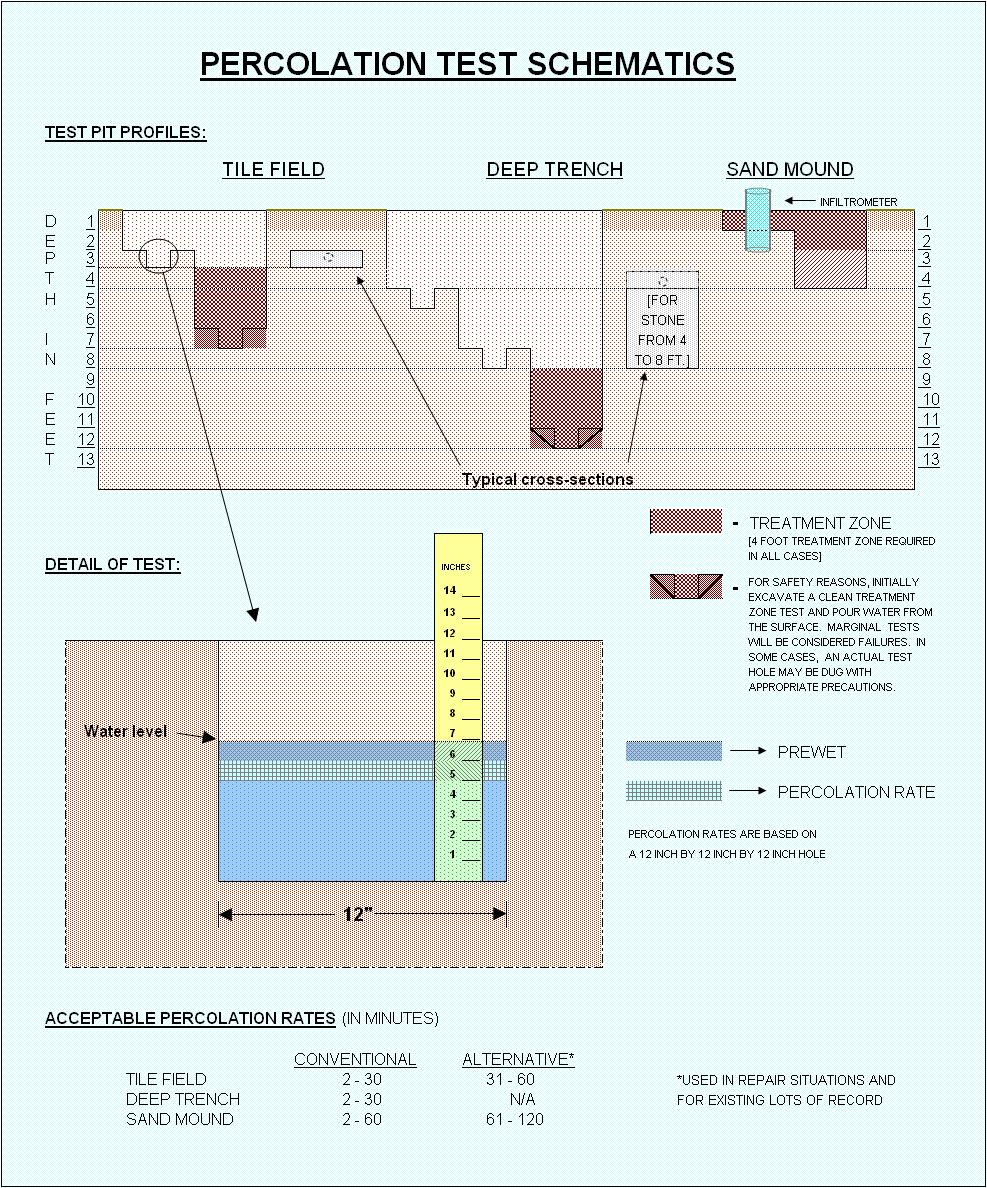Environmental Health Percolation Tests/Wet Weather Testing
Effective March 05, 2024:
Based on the most recent data, and in accordance with Maryland Sewage Disposal and Subdivision regulations (COMAR 26.04.02.04B and 26.04.03.02A), the testing ALL of those soils identified as “wet weather soils” may begin immediately. Ground water levels are at or above normal and the requirement that “soil percolation tests and any other tests as may be required shall be performed at the time of year when the highest water table can be expected at the on-site sewage disposal area” has been satisfied. This decision will be re-evaluated on a weekly basis.
For scheduling, please contact the Environmental Health Specialist who reviewed your plan. As usual, fees must be paid prior to scheduling percolation tests.
Percolation Tests The suitability of soil for the subsurface disposal of sewage is determined by its physical characteristics and percolation rates. Physical characteristics include percentage of rock, evidence of groundwater, and depth to rock and/or groundwater. A percolation test measures the rate that clear water seeps into the soil from a standard test hole.
There are three types of conventional percolation tests: Tile field, Deep trench, and Sand mound. The tests are conducted at the depth at which the septic disposal system will be installed, with an additional test conducted four (4) feet below to determine the soil suitability to filter the sewage effluent for tile field and deep trench systems. An additional piece of equipment, an infiltrometer, is used to conduct sand mound tests. Percolation rates for conventional tile field and deep trench systems cannot exceed 30 minutes, and sand mound tests cannot exceed 60 minutes. A percolation rate of less than 2 minutes is not acceptable. To file for a percolation test, an application must be made and fees paid at the Environmental Health Bureau, Carroll County Health Department. After that has been completed, the applicant must arrange for an excavator to dig the test holes. Any expenses associated with this step are the applicant’s responsibility. Usually, the excavator will contact the Health Department’s Area Environmental Health Specialist to schedule a test date. Arrangements for an appointment should be made 3 weeks in advance of the testing. Percolation tests are then conducted and results are mailed to the applicant and filed at the Health Department until a well and/or application is received.
The purpose of a percolation test is to determine the suitability of soils for the installation of a septic system and treatment of sewage effluent. State regulations require that there be at least 4 feet of satisfactory material below the bottom of an on-site sewage disposal system. For this reason, a percolation test is excavated to a depth 4 feet below the depth of the proposed system installation. Physical appearance of the soil is then evaluated. If there is evidence of water or the soils contain excessive rock, the test is considered disapproved for the proposed system. In the case of tile field or deep trench systems, if the soil is not excluded based on appearance, actual tests are conducted at the depth of the proposed system and 4 feet below the depth. These tests are conducted in the following manner:
- 12 inch by 12 inch by 12 inch test holes are dug at the required depths.
- A ruler is placed in an upright position within the test hole.
- Water is poured into the hole to a depth of 7 inches.
- The water is allowed to drop an initial inch to saturate the soil.
- The rate of the second inch is timed to determine the percolation rate.
In some cases, the rate of the third inch is used if it does not appear that the rate has stabilized. A passing rate for tile field and deep trench tests can be from 2 to 30 minutes. In the case of sand mound testing, an additional piece of equipment is utilized. An infiltrometer is a simple metal cylinder 12 inches in diameter and two to three feet in length. The test hole is excavated to a depth of 4 feet and any evidence of water or rock in noted. If excessive rock or evidence of water at a depth of 2 feet or shallower, the soils are unsuitable for a sand mound system. Otherwise a test may be conducted. The most restrictive layer of soils within the top 2 feet is identified and a shelf is excavated at this depth. The infiltrometer is placed on this shelf and forced downward into the soil and the soils are tamped around the outside of the infiltrometer to assure an adequate seal. A rate is determined in basically the same manner as outlined above. Acceptable rates are from 5 to 60 minutes.

Why do some properties have to be tested during the wettest time of the year?
Rain and snow can put a damper on most land developers’ plans. There are situations, however, where too little of the wet stuff can actually slow the development process. This happens where the proposed house lots or commercial sites will use septic systems and there is concern about lots of clay in the soil or a shallow water table. The reason for this has to do with the way a septic system is designed. Septic systems are designed according to the soil in which they will be installed. You have to answer two questions when you evaluate soils for septic systems. First, how fast will liquid percolate, or seep, into the soil? Second, how deep do the good soils go beneath the septic system’s gravel trench or sand mound? The wetter the soil, the slower liquid will pass through it. This is why soil must be wet all the way through before you record a percolation rate. In most soils, this is done at the time of testing by letting some of the water used for testing soak into the soil. Soils with a lot of clay, however, may need weeks of rainfall or snowmelt before you can tell how they will really function during the wettest time of the year. That’s because clay particles swell very slowly over time. While a test in these soils may appear to pass during the summer months, it may fail miserably in March or April. It would be a mistake to install a system based on such a misleading test. It could lead to a failing system and a major headache for the property owner.
Concerning the depth of good soils, Maryland regulations recognize that at least four feet of good filtering soil are needed to clean up the sewage effluent (the liquid portion of sewage) from a septic system. When you have four feet of good soils between your septic system and the water table, groundwater should not become contaminated. In much of our county, water tables are rather deep. However, in low areas, near streams, and in certain types of soils, water tables are much closer to the surface and seasonal fluctuation can present a problem. It is not unusual for a water table to rise five or more feet in the winter and spring. Here, too, soil evaluations conducted in the summer or fall will not reveal the full picture and poor timing could also lead to system failure.
Based on the two concerns described above, Maryland regulations require that percolation tests “be performed at the time of year when the highest water table can be expected at the on-site sewage disposal area.” Where water tables are deep and the soils are not very clayey, tests can be run year round. Other sites, however, are restricted to the wet weather testing season. Generally, this time period is considered to be February 1 through April 15. These dates are fine-tuned each year based on water table levels and how much it has rained or snowed. In a very wet year, testing may start earlier than February and/or go beyond April 15. On the other hand, if there has not been enough precipitation, the wet weather season could be shortened or cancelled.
If someone wants to run percolation tests on their property, they must have a surveyor send a plan of that property to the Health Department. Since the wet weather season is so short, there is a deadline for getting these plans in. If a developer or property owner wants to have their property evaluated during the wet weather season, their surveyor must get the proper plans to the Health Department by February 28 of the same year. Developers should submit their plans well before the deadline. This will help in two ways. First, if there are problems, there is time for the Health Department to review the plan and send its comments to the surveyor. The surveyor can then send a corrected version of the plan back to the Health Department. Also, it is not unusual to encounter problems with wet weather soils. Sometimes things do not work out as everyone had hoped and it is necessary to regroup and try again. So a second benefit to getting plans in early is that testing can be scheduled as early as possible in the wet weather season. If things do not go well, there should be time for the surveyor to revise the plan, get it back to the Health Department before February 28, and get approval to run more percolation tests. Anyone who has questions about wet weather soils or the wet weather testing period can contact the Carroll County Health Department’s Bureau of Environmental Health.
